
Podophyllum peltatum is an herbaceous perennial plant in the family Berberidaceae. Its common names are mayapple, American mandrake, wild mandrake, and ground lemon. It is widespread across most of the eastern United States and southeastern Canada.

The European corn borer, also known as the European corn worm or European high-flyer, is a moth of the family Crambidae. It is a pest of grain, particularly maize. The insect is native to Europe, originally infesting varieties of millet, including broom corn. The European corn borer was first reported in North America in 1917 in Massachusetts, but was probably introduced from Europe several years earlier. Since its initial discovery in the Americas, the insect has spread into Canada and westwards across the United States to the Rocky Mountains.
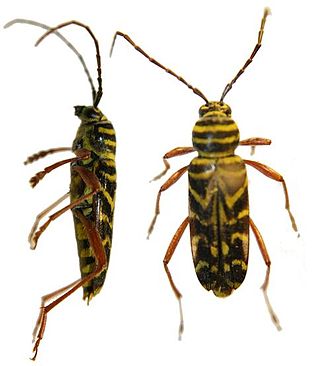
Megacyllene robiniae, commonly known as the locust borer, is a species of longhorn beetle endemic to eastern North America. It is a serious pest of Robinia pseudoacacia, the black locust tree, with which it is sympatric.
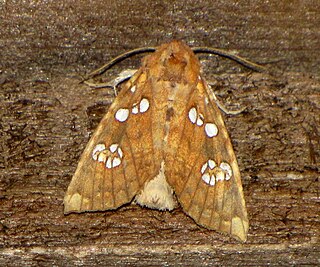
Papaipema is a genus of moths of the family Noctuidae. The genus was erected by John B. Smith in 1899.

Papaipema cataphracta, the burdock borer, is a moth of the family Noctuidae. It is found from Quebec and Maine to Florida, west to Louisiana, north to Saskatchewan.

Chilo suppressalis, the Asiatic rice borer or striped rice stemborer, is a moth of the family Crambidae. It is a widespread species, known from Iran, India, Sri Lanka, China, eastern Asia, Japan, Taiwan, Malaysia to the Pacific.

Sesia tibialis, the American hornet moth, poplar clearwing borer or cottonwood crown borer, is a moth of the family Sesiidae. It is known from North America, including British Columbia, Colorado, Utah, Michigan, Montana, Washington, California and Arizona.

Busseola fusca is a species of moth that is also known as the maize stalk borer. It is known from Ethiopia.

Hylobius transversovittatus is a species of weevil in the family Curculionidae. It is native to the Old World where both adults and larvae feed on purple loosestrife. This plant is regarded as an invasive species in North America and the weevil has been introduced into both the United States and Canada in an effort to control the plant.

Decodon verticillatus, the sole living species in the genus Decodon, is a flowering plant in the family Lythraceae. It is commonly known as waterwillow or swamp loosestrife. It is native to wetlands in the eastern half of the United States and Canada.
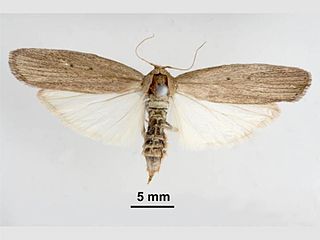
Eldana is a genus of moths of the family Pyralidae containing only one species, the African sugar-cane borer, which is commonly found in Equatorial Guinea, Ghana, Mozambique, Sierra Leone and South Africa. Adults have pale brown forewings with two small spots in the centre and light brown hindwings, and they have a wingspan of 35mm. This species is particularly relevant to humans because the larvae are a pest of the Saccharum species as well as several grain crops such as sorghum and maize. Other recorded host plants are cassava, rice and Cyperus species. When attacking these crops, E. saccharina bores into the stems of their host plant, causing severe damage to the crop. This behavior is the origin of the E. saccharrina's common name, the African sugar-cane borer. The African sugar-cane borer is a resilient pest, as it can survive crop burnings. Other methods such as intercropping and parasitic wasps have been employed to prevent further damage to crops.

Samea multiplicalis, the salvinia stem-borer moth, is an aquatic moth commonly found in freshwater habitats from the southern United States to Argentina, as well as in Australia where it was introduced in 1981. Salvinia stem-borer moths lay their eggs on water plants like Azolla caroliniana, Pistia stratiotes, and Salvinia rotundifolia. Larval feeding on host plants causes plant death, which makes S. multiplicalis a good candidate for biological control of weedy water plants like Salvinia molesta, an invasive water fern in Australia. However, high rates of parasitism in the moth compromise its ability to effectively control water weeds. S. multiplicalis larvae are a pale yellow to green color, and adults develop tan coloration with darker patterning. The lifespan, from egg to the end of adulthood is typically three to four weeks. The species was first described by Achille Guenée in 1854.
Papaipema birdi, the umbellifer borer, is a species of moth of the family Noctuidae. It is found from Quebec to Alberta and south in the east to New Jersey.
The meadow rue borer is a species of moth of the family Noctuidae. It is found in the north-eastern United States and southern Canada east of the Rocky Mountains.

Vernonia gigantea is a species of perennial plant from family Asteraceae found in United States and Canada. The plant is native to the eastern United States, north to New York state and Ontario, and southwest to Texas.
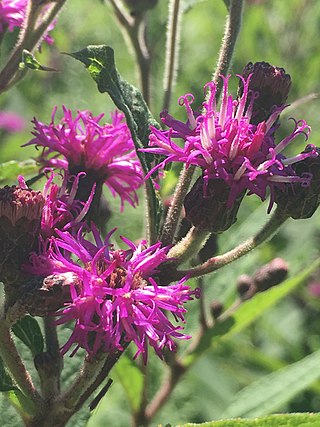
Vernonia missurica, the Missouri ironweed, is a species of magenta-flowered perennial plant from family Asteraceae native to the central and east central United States.
Chilo partellus, the spotted stalk borer or spotted stem borer, is a moth in the family Crambidae. It was described by Charles Swinhoe in 1885. It is found in India, Pakistan, Iran, Ethiopia, Lesotho, Madagascar, Malawi, South Africa, Sudan, Tanzania, Uganda and on Mayotte.
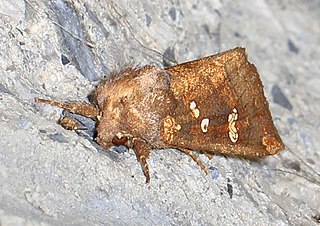
Papaipema duovata, the seaside goldenrod stem borer or seaside goldenrod borer, is a moth that is native to North America, where it is found in the coastal plain from the gulf coast north to at least New Jersey. The species is listed as threatened in Connecticut. It was described by Henry Bird in 1902.
Papaipema eryngii, the rattlesnake-master borer, is a species of cutworm or dart moth in the family Noctuidae. It is found in North America. It bores into the rattlesnake master, Eryngium yuccifolium, at the stalk, inverts and develops, killing the plant in the process. In order to mature, the moth needs a mature rattlesnake master or multiple young stalks.

Oemona hirta, the lemon tree borer, also known as the whistling beetle or the singing beetle, is a longhorn beetle endemic to New Zealand. Its larvae are generalist feeders, boring into the wood of a wide variety of trees, native and introduced. When citrus orchards were first established in New Zealand, this beetle started inflicting serious damage, and so gained the name "lemon tree borer". Four species within the genus Oemona have been identified, suggesting that more species could be found. When disturbed by predators or humans, the adult beetle stridulates creating a "rasp" or "squeak" sound by rubbing its thorax and head together against an area of thin ridges. Māori would eat a liquid called "pia manuka", which was produced by manuka trees when its wood was damaged by the larvae. When Captain Cook first arrived in NZ, his naturalists, Banks and Solander, collected a lemon tree borer in their first collection between 1769 and 1771. This oldest collected specimen can be found in the British Museum. A few years after the first collection, the species would be first described by the Danish naturalist Fabricius in 1775.

















